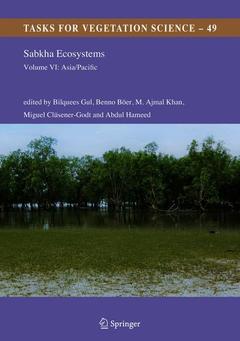Description
Sabkha Ecosystems, 1st ed. 2019
Volume VI: Asia/Pacific
Tasks for Vegetation Science Series, Vol. 49
Coordinators: Gul Bilquees, Böer Benno, Khan M. Ajmal, Clüsener-Godt Miguel, Hameed Abdul
Language: English
Subjects for Sabkha Ecosystems:
Keywords
Salinity; Halophyte; Sabkha; Ecosystem; Arid Environment; coastal sciences
511 p. · 17.8x25.4 cm · Hardback
Description
/li>Contents
/li>Comment
/li>
This book is the sixth and final volume in the Tasks for Vegetation Science book series, and it concludes the most comprehensive scientific documentation dealing with hypersaline ecosystems of the world.
1. Halophyte Research, Conservation & Development - The role of UNESCO Biosphere Reserves in Asia/Pacific
2. Evidence for the role of salinity and alkalinity in plant diversification in Australia
3. Aspects of the Abu Dhabi Sabkha
4.Comparative seed germination ecology of sabkha and playa halophytes of Pakistan
5. Plants of sabkha ecosystems of the Arabian Peninsula
6. Desert Halophytes: Alleviating the Pressure on the Scarce Resources of Arable Soil and Fresh Water
7. Drone-based vegetation assessment in arid ecosystems
8.Salt-induced Changes in Growth and Damage-avoidance-mechanisms of Hydroponically Grown Chinese Kale (Brassica alboglabra L.)
9. Growth dynamic of Tamarix chinensis plantations in coastal heavy saline land and its ecological effect
10. Mechanisms of ion transport in halophytes, from roots to leaves
11. Interpretation of Holocene Carbonate-Evaporites of Coastal and Inland Sabkhas of Abu Dhabi (United Arab Emirates) Using Landsat Satellite Images and Field Survey
12. Climate change impacts on salt marsh vegetation ecophysiology
13. Morphology and betalain characterization of ‘ice plants’ (Aizoaceae) from the coast of Wellington, New Zealand
14. Salt-tolerance and potential uses for saline agriculture of halophytes from the Poaceae
15. Phenotyping through Infra-Red Thermography in stress environment
16. The Mangroves of Myanmar
17. Potentially domesticable chenopodiacea halophytes of Iran
18. Plant Growth Promoting Bacteria associated to the halophyte Suaeda maritima (L.) in Abbas, Iran
19. Quinoa: A new crop for harsh environments
20. Difference in antioxidant defense system between the halophytes and glycophytes to overcome the salinity stress
21. Diversity and distribution of salt-tolerant plants of the United Arab Emirates: perspectives for sustainable utilization and future research
22. Framework for rapid evaluation of a mangrove restoration site: A case study from Indian Sundarban
23. Mangrove Biogeography of the Indo-Pacific
24. Short Communications – Suggestions for Improving Science Communication for Halophyte Conservation, Research and Development
25. Ligno-cellulosic biomass from sabkha native vegetation: a new potential source for fiber-based bioenergy production
26. The Floristical, Ecological and Syntaxonomical Characteristics of Salt Marshes and Salt Steppes of Turkey
27. Temporal variations in water and ion relations of coastal halophytes
28. Mangrove Cover, Biodiversity and Carbon Storage of Mangrove Forests in Thailand
29. Pollen morphology of the genus Tamarix in Israel
30. Species distribution in different ecological zones and conservation strategy of Halophytes of Sundarbans Mangrove Forest of Bangladesh
31. Cash Crop Holophytes of China
32. Sabkha Ecosystems Vol VI - Asia Pacific: Summarizing the Story
Discusses important adaptation opportunities for climate change and clean energy, food security, and biodiversity conservation
Outlines targets for achieving the United Nations Sustainable Development Goals Zero Hunger, Clean Energy, Climate Action, Economic Growth, Sustainable Communities and Biodiversity on land and below water
Presents scientific documentation initiated and supported by UNESCO
The sixth and final volume in the Tasks for Vegetation Science book series




